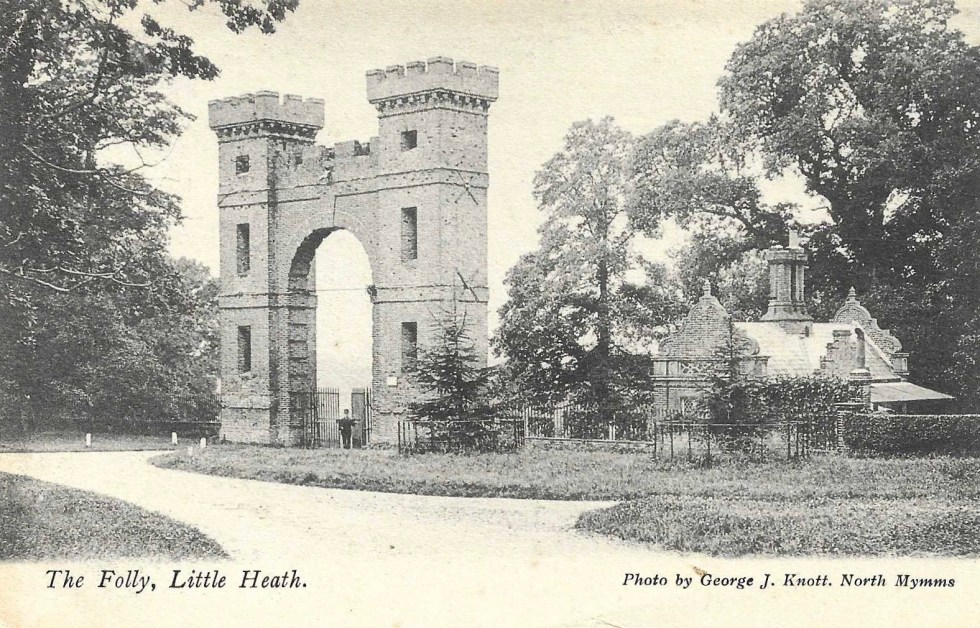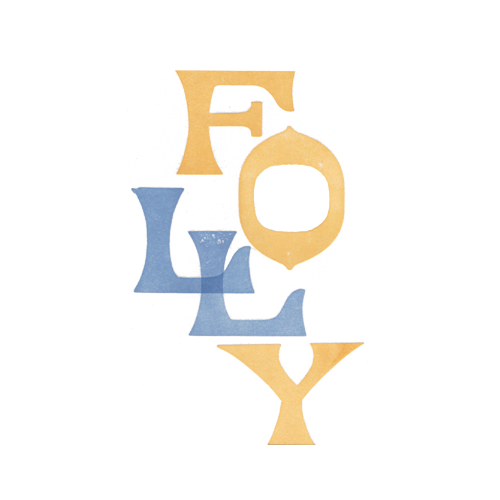This fine brick arch is one of the few surviving eighteenth century features of the designed landscape of Gobions in Hertfordshire. The mansion is long gone, and much of the park has been developed for housing and a golf course, but the arch still stands – although it has come very close to collapse.

The exact early history of the arch is not known, but it is generally accepted to have been built for Jeremy Sambrooke (died 1754), who bought the estate in the first decade of the eighteenth century. It is attributed to the architect James Gibbs, who is known to have designed garden buildings for Gobions (also often referred to as Gubbins), but to date no documentary evidence has been found.

The arch straddled an entrance which led to a tree-lined drive down into the park, laid out to a design attributed to Charles Bridgeman, although Sambrooke himself probably made a significant contribution. By 1726 visitors could admire woods cut through with walks and ornamented with canals, statues and an ampitheatre.

Although a number of contemporary accounts describe the fine park in some detail, the arch is not mentioned and hence it remains something of a mystery, although it is clearly shown on a map thought to have been drawn before Bridgeman’s death in 1738 (above).

John Hunter, a wealthy merchant, bought the Gobions estate in 1777. It seems that he removed the formal gardens admired by earlier generations and naturalised the park, his principal interests being ’tillage and grazing’. Early editions of Ambulator: or, A pocket companion in a tour around London, describe the delightful formal pleasure grounds, but by the time the 6th edition appeared in 1793, Gobions was described as ‘once famous for its fine gardens in the ancient taste’. Happily, the arch survived under the new owner.
In 1786 the Brookmans estate, which stood adjacent to Gobions, was bought by Samuel Robert Gaussen. His descendant Robert William Gaussen added the Gobions estate to his land holdings after John Hunter’s death in 1827, and in 1842 the Gobions mansion was dismantled and sold for the materials after Gaussen decided to ‘throw Brookmans and Gobions parks into one’. By this date the tithe map shows that the arch was known as the ‘folly’ and the open meadows beyond as ‘Folly Park’.

A fire in 1891 destroyed the Brookmans house, and the Gaussens created a new home in the stable block. In 1911 the estate, now known as Brookmans Park, was home to Hubert Gaussen, and he gave permission for the Herts County Open Speed trials to take place in his grounds. This wonderful photograph captures Jack Holroyd, on his Motosacoche motorcycle (described in 1911 as ‘The Motorcycle that is Booming’), setting off over the starting line. Although Holroyd was not the fastest on the day, he did go on to have great success, and later manufactured his own models as well as running a motorcycle shop on Regent Street, London.

The Gaussen family offered the estate at auction in 1923 and it was bought by developers to create the ‘Brookmans Park Estate’ in the ‘gently undulating and well-wooded country on the borders of Middlesex and Hertfordshire’. The rural setting was always emphasised in advertisements, and a 1929 sales pitch made the rash promise that the ‘Home Farm will always supply Grade A milk, real new-laid eggs, and fresh butter to residents’ (today a trip to Sainsbury’s at Potters Bar is required). The Brookmans Park railway station opened in 1926, and a golf course in the former parkland in 1930. Meanwhile ‘Country Homes 35 Minutes from Town’ were snapped up by buyers keen to live in bucolic Brookmans Park, for as the sales brochure noted ‘under the strenuous conditions of modern city life, country surroundings are becoming not so much a luxury as a necessity’.

Happily the arch and its lodge were left in peace on the edge of the estate, although the lodge had fallen into disrepair. In the early 1990s the lodge, complete with folly arch, was offered for sale: although the Gobions Woodland Trust, already custodian of parts of the park, was keen to buy the arch, it went instead to a private buyer who built a new house to replace the derelict lodge.
Meanwhile the grade II* listed arch, patched up on a number of occasions over the centuries, had fallen into a very poor condition, with a huge crack above the arch, and the North Mymms Greenbelt Society appealed to English Heritage to take action and save the folly from collapse. The arch was propped up whilst discussions continued between English Heritage, the private owner of the lodge and arch, and local amenity societies. It took four years to resolve the situation and for work to begin. The restoration was completed in 2023.

The arch remains in private ownership, but can easily be seen at the junction of Swanley Bar Lane and Hawkshead Road: the pretty old sign in the postcard above has gone, but you can’t miss the mailbox at the lodge.

You can also walk in the former parkland (listed grade II) and enjoy views back to the arch. The woodland is now managed by the Herts and Middlesex Wildlife Trust.

For lots more on Brookmans Park see the excellent North Mymms History Project website. You can read more about the nabob John Hunter here.
The Flâneuse must conclude with the story that a farthing was placed between each pair of bricks when the arch was constructed. No evidence of this extravagance has yet been found.
Thank you for reading. As ever, you are encouraged to scroll down to the comments box to share any thoughts.






Patrick says:
I was born in the parish in Welham Green and used to be taken past the folly on my way to and from Kindergarten. The fable of the penny under each brick was current
then. I have an old print of the canal at Gubbins. My old home is now a housing Estate.
Perhaps my love of follies was subliminally created by this early exposure!
Editor says:
Good morning Patrick. Never underestimate the power of a fine folly on a young mind! Thanks for confirming the wonderful story about the farthings.
TOM GARDNER says:
TOM (USA)
HOW HANDSOME, HOW WONDERFUL THAT IT WON ITS BATTLE AGAING TIME.
WE SHOULD ONLY BE SO FORTUNATE.
I’VE SOLVED MY OWN AGEING CHALLENGE VIA A FULL BEARD; HIDES A GREAT MANY FLAWS.
MERCY BUCKETS!
TOM